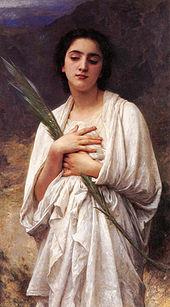Palm branch
Since a victory signals an end to a conflict or competition, the palm developed into a symbol of peace, a meaning it can have in Islam,[1] where it is often associated with Paradise.Reliefs from the 9th century BC show winged genii holding palm fronds in the presence of the Sacred Tree.In recognition of the alliance, Cimon of Athens erected a bronze statue of a palm tree at Delphi as part of a victory monument commemorating the Battle of the Eurymedon (469/466 BC).[9] In addition to representing the victorious League, the bronze palm (phoinix) was a visual pun on the defeated Phoenician fleet.The Roman senator Symmachus, who tried to preserve Rome's religious traditions under Christian domination, is pictured on an ivory diptych bearing a palm branch in an allegorical triumph over death.Additionally, the Midrash[18] notes that the binding of the Four Species symbolizes the desire to unite the four "types" of Jews in service of God.On 10 April 1688 it was decided by the Congregation of Rites that the palm when found depicted on catacomb tombs was to be regarded as a proof that a martyr had been interred there.The general significance of the palm on early Christian monuments is slightly modified according to its association with other symbols (e.g., with the monogram of Christ, the Ichthus (Fish), or the Good Shepherd).[25] Crusaders would carry or wear an image of one, seen today in the Catholic Order of the Holy Sepulchre, which still awards a Palm of Jerusalem decoration.[39] Palms appear on the flags and seals of several places where they are native, including those of Malta, Haiti, Paraguay, Guam, Florida, Poland, Australia and South Carolina.In Arabic, the term Fog al-Nakhal (فوق النخل), which literally translates to "above the palm trees", is an idiom used to indicate euphoria, satisfaction or strong happiness.






William-Adolphe BouguereauNear EastMediterranean worldPhoenixMesopotamian religionsancient EgyptJudaismdate palmfestivalSukkotancient GreeceVictory personifiedancient RomeChristianityTriumphal Entry into JerusalemPalm SundayGospel of JohnChristian iconographyRevelationcoconut palmtropicsSolidusConstantine Imilitary trophychristogramAssyrian religionSacred TreeIshtarIshtar GateMesopotamiaInannaAncient EgyptiansKingdom of NriParthianDrakht-e AsurigPhoeniciaancient GreekethnonymArchaic GreeceApolloDelian LeagueCimon of AthensDelphiBattle of the Eurymedonmetonymgoddess VictoryJulius Caesarvictory at PharsalusTrallesmilitary triumphchristogramsSymmachusRome's religious traditionsAchaemenidlibation bowlBabylonDurand StoneKassitePoseidonreversetetradrachmAntimachus I TheosBactriaRoman mosaicTosher RebbeMontrealHallelFour SpecieshadassmyrtlearavahwillowMidrashRosh HashanahJudaeaIudaea Capta seriesHasmoneanHerod AntipasHerod the GreatMasadaMethuselahPalermoEberhard I, Duke of WürttembergpilgrimageJerusalemKnight of the Holy Sepulchretriumphal entry of Christ into JerusalemChristiansChristian artcrossescrucifixesShrovetidenarthexShrove TuesdayAsh WednesdaymartyrsattributeOrigenActs of the MartyrsCongregation of RitesBenedict XIVmonogramIchthusMiddle AgespilgrimsHoly LandCrusadersCatholicOrder of the Holy SepulchrePalm of JerusalemCustody of the Holy LandCatholic ChurchJerusalem Pilgrim's CrossSaint LawrenceBasilica of Sant'Apollinare NuovoRavennaSaint SebastianAndrea del SartoChrist ChildMaarten PepynSan Pedro MártirSanto Domingo Díaz OrdazOaxacaEaster palmOttomanparadisical